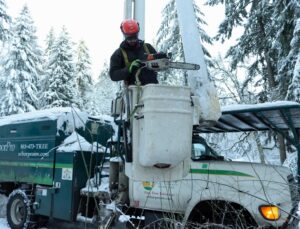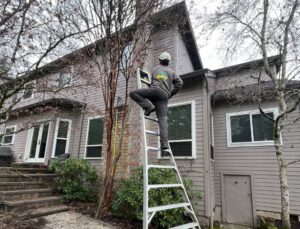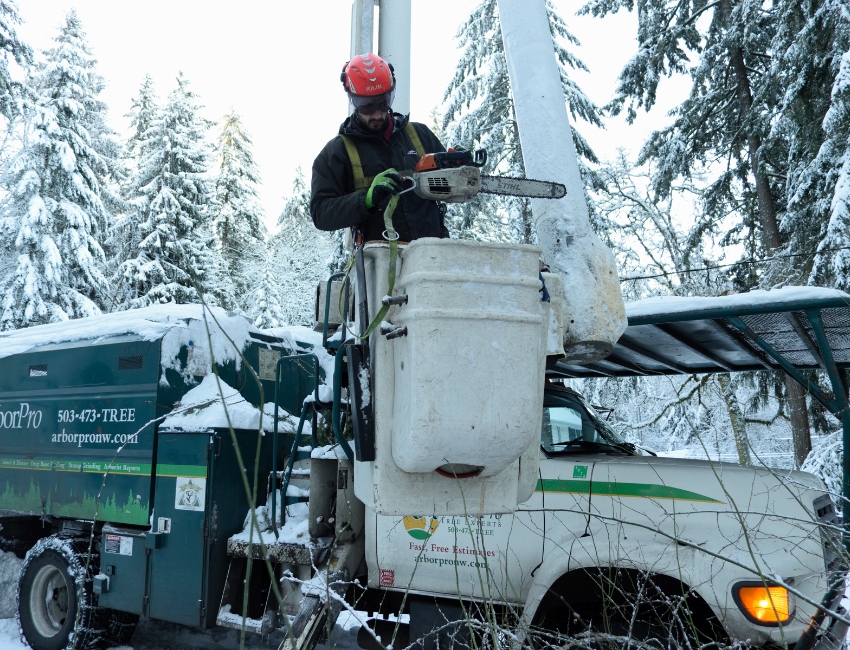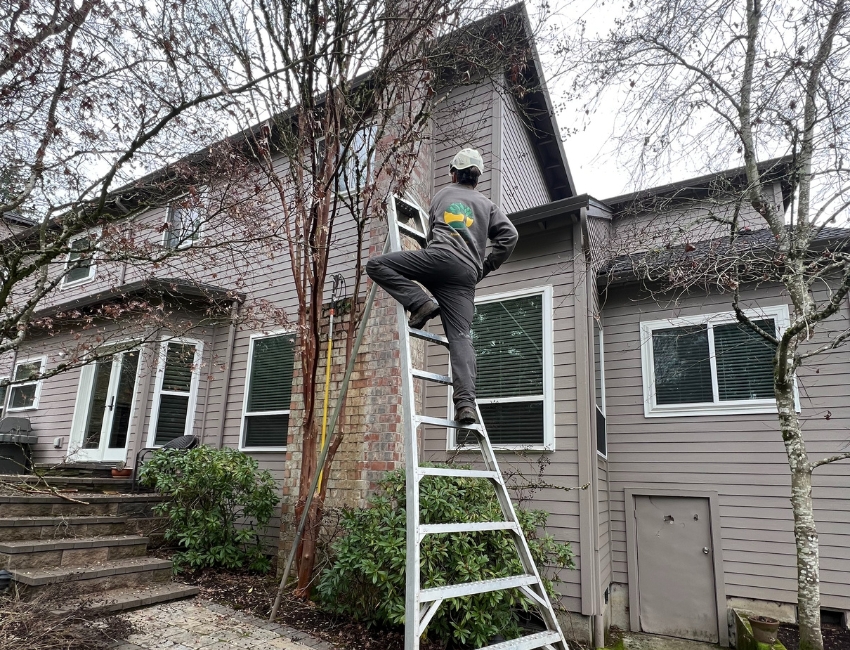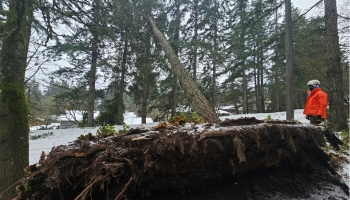Emerald Ash Borer: A New Threat for Portland Ash Trees
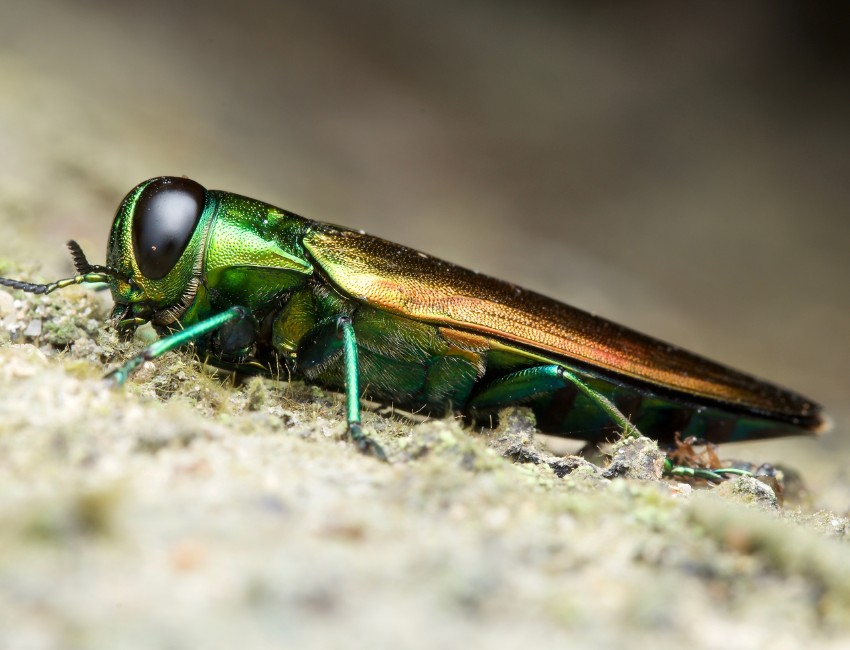
The emerald ash borer (EAB) has officially arrived in Oregon – and while it hasn’t reached the City of Portland yet, it’s closer than ever. This invasive pest was first confirmed in Forest Grove and has since been found in Yamhill, Marion, and Clackamas counties. Though its spread is still limited, experts agree it’s only a matter of time before EAB moves into new areas, including Portland.
If you have ash trees (popular as shade trees) on your property, you need to know what to look for to protect yourself from this pest.
Key Takeaways:
- Emerald ash borer (EAB) has recently spread to Oregon, posing a significant threat to approximately 94,000 ashes that comprise about 1% of the city’s tree canopy.
- EAB larvae damage trees by burrowing under the bark and disrupting nutrient flow. This process can kill mature ashes within a few years and is often detected too late for effective treatment.
- Signs of EAB infestation include upper branch dieback, small D-shaped exit holes, S-shaped markings under bark, and increased woodpecker activity.
- Prevention methods include injecting preventive insecticides every two years, buying only local firewood, reporting EAB sightings, and, in some cases, preemptive tree removal.
- Once emerald ash borer severely infests a tree, removal is often the only safe option – local officials have set up quarantines and removal programs to help slow the spread.
Emerald Ash Borer: An Emerging Threat to Portland Trees
Emerald ash borer isn’t just another insect – it’s one of the most destructive tree pests North America has ever seen. While Portland hasn’t seen an official case yet, the pest is already close, and once it shows up, it spreads fast. Cities that waited too long to act have lost thousands of trees in just a few years.
Portland has a lot on the line. Ash trees were planted across the city for their hardiness and shade, but they’re now extremely vulnerable. Without early detection and quick action, entire neighborhoods could lose canopy cover – and homeowners could face costly removals and lost property value.
“I’ve been hearing about emerald ash borer for over a decade, and it’s always been one of those pests we knew would reach us eventually. Now that it’s in Oregon, it feels a lot more real—especially because it targets Oregon ash, one of our few native hardwoods. Once it’s here, we could start losing trees that are a big part of our forests and our neighborhoods.” – Alex Hoekstra, ArborPro Certified Arborist
Before EAB, ashes were popular street and landscape trees. To better understand the risks, the City of Portland conducted a tree inventory in 2024 to determine how many ashes were in the city. Some of the findings include:
- There are around 94,000 ashes in Portland, making up about one percent of the tree canopy.
- There are 16,575 ashes on residential properties.
- Oregon ash (Fraxinus latifolia) is most common in natural areas, making up about 3 percent of all trees.
Researchers are still trying to determine how EAB will impact the ecosystem if it begins to kill ash trees across Portland. Many residents planted ashes for shade and to help keep cool in the summer, but there is a worry that the decreased ash population will increase urban heat waves.
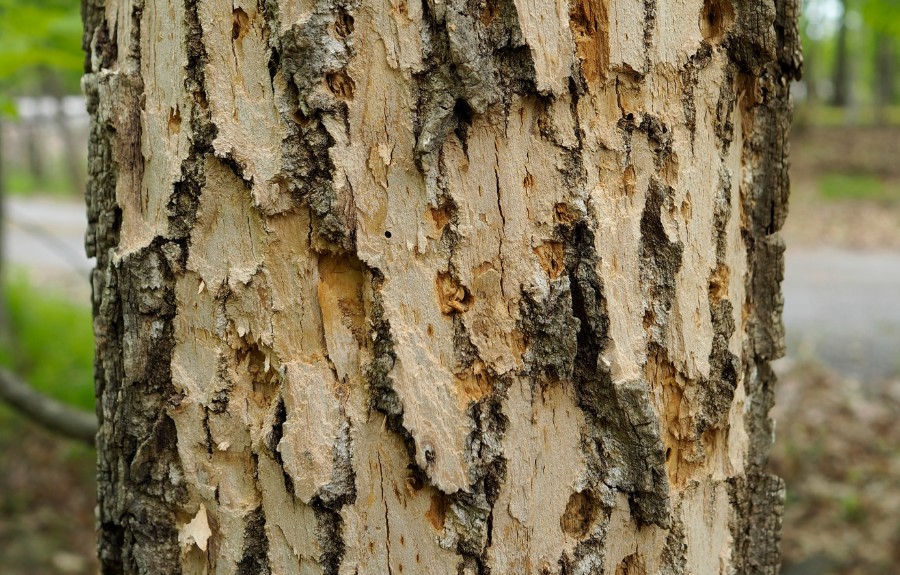
Exit holes like the ones in this picture are a sign of emerald ash borer infestation in your tree.
How Emerald Ash Borer Damages Your Trees
EAB likely conjures up images of a small metallic green beetle. And while the adults are easily identifiable, they aren’t what puts your tree in danger – it’s the larvae.
The larvae burrow into the ash in the summer and begin to feed on the inner bark. As they continue feeding, they restrict the tree’s ability to transport nutrients and water to and from the canopy. Removing the bark of an EAB-infested specimen will reveal the trademark galleries they leave behind during feeding.
A tree unable to transport nutrients will quickly die and become a hazard to your property. EAB can kill most mature ashes within a few years, though the timeline will depend on the species. Once symptoms emerge, it is often too late to do anything.
Symptoms of EAB Activity in Your Trees
Common symptoms of an EAB infestation in your tree include:
- Upper Branch Dieback: As the damage increases, you will notice the branch dieback in the upper portions of your canopy.
- Entrance and Exit Holes: EAB larvae create small S-shaped markings when they enter your tree. When they leave, a keen eye may notice small D-shaped exit holes. These holes are difficult to detect due to their small size and the fact that they can be out of easy eyesight.
- Woodpecker Activity: Woodpeckers feed on EAB larvae in your trees. If you hear or see increased woodpecker activity on your ash, it may be a sign of EAB.
PRO TIP: Identifying EAB damage requires a keen eye. By the time the symptoms become apparent, the only option is often to remove the tree to protect your property from damage. Have an arborist conduct an assessment of your trees to check for signs of EAB infestation.
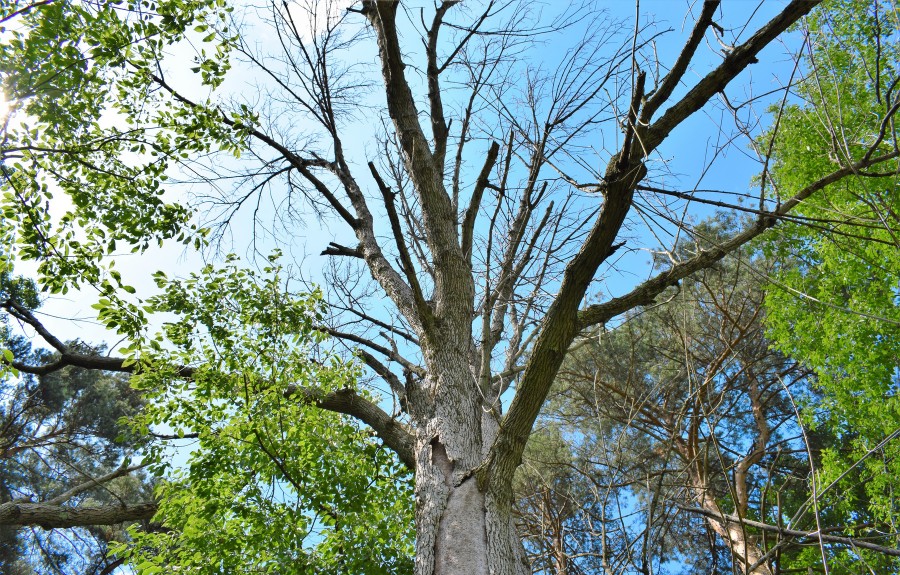
A dead ash tree that was killed by emerald ash borers (EAB).
Prevention and Treatment of EAB
While the danger of emerald ash borer is significant anywhere with the pest active, there is hope to save some of our ashes. Arborists have developed preventive measures to attempt to save as many of our ash species as possible.
How Professionals Prevent EAB Damage
We use a combination of tactics to try and prevent EAB, including:
- Preventive Treatments: Preventive trunk injections of insecticides can protect your ashes before there is any EAB presence in your yard. Have an arborist inject any old or high-value ashes once every two years for maximum effectiveness.
- Buy Firewood Locally: Ash makes great firewood. However, with the advent of EAB, it is dangerous to buy it from somewhere that isn’t local, as you risk bringing the pest to the area. If you purchase firewood, ensure it is from a local company to avoid introducing an invasive species to your property.
- Report Cases of EAB: The local government of Portland has asked residents to report any sightings of EAB to help us understand its distribution. You can report sightings online or call 1-866-INVADER.
- Remove Ash Trees Preemptively: If you have an ash on your property and want to be safe, remove it before any symptoms develop and replace it with another species. This option may be a bit extreme at the moment (and Oregon State recommends leaving ash trees for now). However, as the problem worsens, preemptive removal may be a worthwhile decision.
What Local Authorities Are Doing About EAB
Even though the problem in our area is not as severe as in other parts of the country, local organizations and governments are working to try and control the population. The Oregon government has put a permanent quarantine on Washington, Yamhill, Marion, and Clackamas counties, the most hard-hit areas. The quarantine restricts the transportation of any material from ash, white fringe, and olive trees.
In Forest Grove, ground zero for EAB in Oregon, state crews have worked to remove infested ashes to try and slow the spread. These crews have also injected preventive insecticides into nearby ashes in an attempt to save them.
Local governments, including ours in Portland, have been working diligently to inform residents about the dangers of EAB and the signs to spot it. For instance, Portland’s government has created a page on its website with extensive information on EAB and what to do about it to keep the public educated.
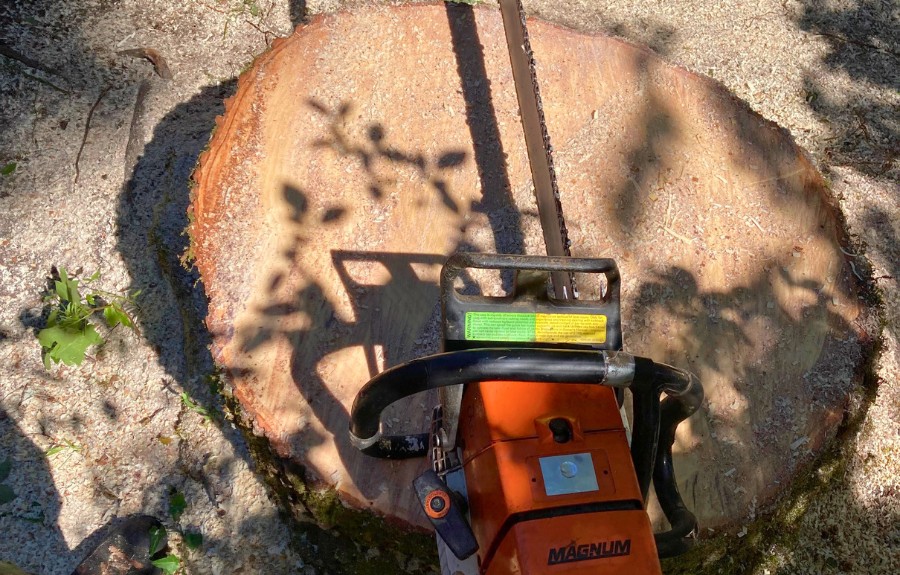
In many cases, the only thing to do for an ash tree after an EAB infestation is to remove the tree.
Treatment Once EAB Infests Your Trees
“Once an infestation occurs, treatment is much less effective for trees. Ashes can’t recover from the damage caused by EAB. So, even if you kill all the EAB larvae in the tree, the girdling will end up killing your ash anyway. That’s why it’s so important to be proactive in dealing with EAB.” – Ryan Queen, ArborPro Certified Arborist
If an arborist determines an EAB infestation is too severe, and the tree will likely die, the only option is to remove it. Dead ash trees are notoriously brittle and prone to breaking. This makes them a danger to your home and difficult for a tree care company to remove.
Frequently Asked Questions About Emerald Ash Borer in Portland
To help you better understand EAB and the danger it poses to your property, we’ve compiled some common questions we hear from homeowners who are worried about the pest.
How can I tell if I have an ash on my property?
Some distinctive features of ash include:
- The branches grow directly across from each other.
- The tree has compound leaves (several leaflets joined together by a woody stem).
- It has at least five leaflets.
If you aren’t sure if you have an ash, consider having an arborist help you identify the trees in your yard.
Can EAB in my neighbor’s trees affect my ashes?
Yes, EAB in your neighbor’s tree can affect your ashes. EAB adults can travel up to ½ mile yearly without any help from humans. If there is EAB in your neighborhood, we recommend preventive treatment for any ash specimens you have.
Can I do preventive treatments for my ash trees myself?
While you can use insecticides with imidacloprid yourself, hiring a professional to handle the job has numerous benefits, including:
- Access to more treatment options
- Expertise in calculating dosage and timing
- Specialized equipment
- Accurate recommendations on whether treatments are worthwhile
What are some trees I can replace my ashes with?
The Oregon State Extension program created a list of replacement trees to plant if you have to remove your ash. Some of their suggestions include:
- Ponderosa pine
- Bitter cherry
- Pacific willow
- Bigleaf maple
- Black cottonwood
- McKenzie willow
ArborPro is Committed to Protecting Portland’s Ash Trees
It will take a concentrated effort from all of us to work to protect our ash trees and prevent Portland forests from losing one of our prominent species. Portland residents should remain alert for signs of EAB and work with arborists to preserve their ashes. If you have these trees and want to keep them alive, the team at ArborPro Tree Experts can help.
Our team keeps up with the latest research and developments on emerald ash borer and how it will apply in the Pacific Northwest. We can treat your trees for EAB or remove them if the pest kills them. Call us today at 503-473-8733 or request a quote online for help with your ashes.

